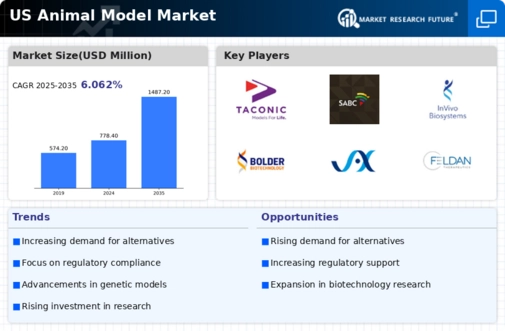Advancements in Genetic Engineering
Advancements in genetic engineering techniques, such as CRISPR, are transforming the landscape of the animal model market. These technologies enable the creation of genetically modified animals that can serve as precise models for human diseases. The ability to tailor animal models to specific genetic profiles enhances their relevance in research. The animal model market is poised to benefit from these innovations, as researchers increasingly seek models that can accurately reflect human genetic diversity. This trend may lead to more effective drug development and personalized treatment strategies, further driving the market's growth.
Growing Focus on Disease Understanding
The increasing emphasis on understanding complex diseases is propelling the animal model market forward. As researchers strive to unravel the mechanisms behind diseases such as cancer, diabetes, and neurodegenerative disorders, the demand for relevant animal models is expected to rise. The animal model market is crucial in providing models that can mimic these conditions, facilitating deeper insights into disease pathology. This focus on disease understanding is likely to drive innovation in model development, ensuring that researchers have access to the most effective tools for their studies.
Expansion of Biopharmaceutical Research
The biopharmaceutical sector is experiencing rapid growth, which is positively impacting the animal model market. With the biopharmaceutical market expected to surpass $500 billion by 2025, the demand for animal models that can aid in drug discovery and development is likely to increase. These models are essential for preclinical testing, allowing researchers to evaluate the efficacy and safety of new drugs before human trials. The animal model market plays a crucial role in this process, as it provides the necessary tools for biopharmaceutical companies to innovate and bring new therapies to market efficiently.
Rising Demand for Personalized Medicine
The increasing focus on personalized medicine is driving growth in the animal model market. As healthcare shifts towards tailored treatments, the need for specific animal models that can accurately mimic human diseases becomes paramount. This trend is evident in the pharmaceutical sector, where companies are investing heavily in research and development. In 2025, the market for personalized medicine is projected to reach approximately $350 billion in the US, indicating a robust demand for animal models that can facilitate this research. The animal model market is thus positioned to benefit significantly from this shift, as researchers require models that can provide insights into individual responses to therapies.
Increased Investment in Research and Development
Investment in research and development (R&D) is a key driver of the animal model market. In the US, R&D spending in the life sciences sector is projected to reach $200 billion by 2025. This surge in funding is likely to enhance the development of advanced animal models that can better replicate human diseases. The animal model market stands to gain from this trend, as researchers seek more sophisticated models to improve the accuracy of their studies. Enhanced R&D efforts may lead to breakthroughs in various therapeutic areas, further solidifying the importance of animal models in scientific research.






















Leave a Comment